
outlook自定义快捷键
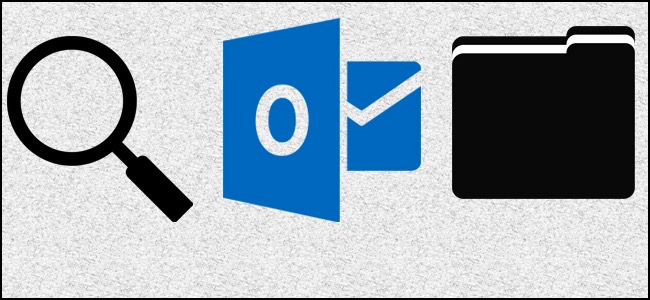
Searching in Outlook is pretty easy, but why bother typing out the same searches over and over if you perform them regularly? Custom Search Folders let you save those custom searches so you can get back to them with just a click or two.
在Outlook中搜索非常容易,但是如果您定期执行相同的搜索,为什么还要反复输入相同的搜索呢? 使用“自定义搜索文件夹”可以保存这些自定义搜索,因此只需单击或单击两次即可返回它们。
And while it’s tempting to just think of Custom Search Folders like a saved search, they’re actually cooler than that. Since they’re automatically updated, they actually work more like virtual folders—similar to the Labels feature in Gmail, except more powerful. Want a folder that shows only messages that are unread, from a certain person, and have one or more attachments? No problem.
尽管将自定义搜索文件夹视为保存的搜索很诱人,但它们实际上比这更酷。 由于它们是自动更新的,因此它们实际上更像是虚拟文件夹,类似于Gmail中的“标签”功能,但功能更强大。 想要一个仅显示来自某人的未读邮件并具有一个或多个附件的文件夹吗? 没问题。
Let’s take a look at how to set them up.
让我们看一下如何设置它们。
在Outlook中创建预定义的搜索文件夹 (Create a Predefined Search Folder in Outlook)
Outlook already has a number of predefined search folders that you can make use of. You can’t further customize any of these, but they’re worth taking a look at first just in case they cover your needs.
Outlook已经有许多可以使用的预定义搜索文件夹。 您无法进一步自定义其中任何一个,但是值得一看,以防万一它们满足您的需求。
To start with, you’ll find your search folders at the bottom of the list of folders in your Outlook data file on the left side of the window. Each data file has it’s own search folder, so if you use Outlook to check more than one account, you can set up different search folders for each one.
首先,您会在窗口左侧Outlook数据文件的文件夹列表的底部找到搜索文件夹。 每个数据文件都有其自己的搜索文件夹,因此,如果您使用Outlook检查多个帐户,则可以为每个帐户设置不同的搜索文件夹。
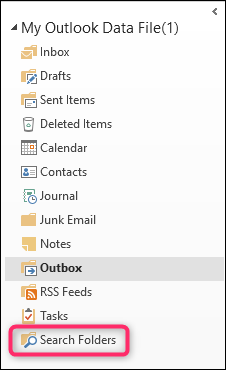
You won’t be able to even select that “Search Folders” folder, though, until you’ve created your first search folder. To create a search folder, switch to the “Folder” tab on the Ribbon, and then click the “New Search Folder” button.
但是,直到创建了第一个搜索文件夹,您甚至都无法选择该“搜索文件夹”文件夹。 要创建搜索文件夹,请切换到功能区上的“文件夹”选项卡,然后单击“新建搜索文件夹”按钮。
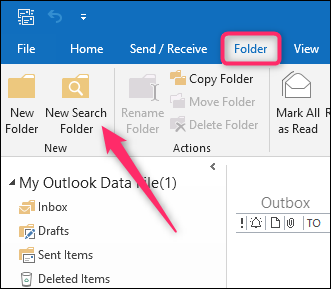
This opens the New Search Folder window. You’ll see a bunch of predefined search folders organized into categories like Reading Mail, Mail From People And Lists, and Organizing Mail. Most of the folders are pretty self-explanatory, so we won’t cover them in detail—you can just browse through them.
这将打开“新建搜索文件夹”窗口。 您将看到一堆预定义的搜索文件夹,这些文件夹分为一些类别,例如“阅读邮件”,“来自人员和列表的邮件”和“组织邮件”。 大多数文件夹都是不言自明的,因此我们不会详细介绍它们-您可以浏览它们。
Here, we’re creating a new search folder that shows unread mail. It’s a super handy search folder to have around because it shows all your unread mail, no matter what folder it’s stored in. Just click the search folder you want to create, and then hit the “OK” button.
在这里,我们正在创建一个显示未读邮件的新搜索文件夹。 这是一个超级方便的搜索文件夹,因为它显示了所有未读邮件,无论它存储在哪个文件夹中。只需单击要创建的搜索文件夹,然后单击“确定”按钮。

Pretty simple, right? Now, let’s take a look at creating your own custom search folders, which are way more powerful.
很简单,对吧? 现在,让我们来看一下创建自己的自定义搜索文件夹的方法,它们的功能更加强大。
在Outlook中创建自定义搜索文件夹 (Create a Custom Search Folder in Outlook)
Custom search folders let you additional criteria that the predefined search folders don’t include—you can pretty much search by any field an Outlook message contains. More importantly, you can create a custom search folder that uses multiple criteria to select messages. For example, you could have one only display message from certain people and that have specific words in the subject line.
自定义搜索文件夹为您提供了预定义搜索文件夹不包括的其他条件-您几乎可以通过Outlook消息包含的任何字段进行搜索。 更重要的是,您可以创建一个自定义搜索文件夹,该文件夹使用多个条件来选择邮件。 例如,您可能只显示来自某些人的消息,并且在主题行中有特定的单词。
To create a search folder, switch to the “Folder” tab on the Ribbon, and then click the “New Search Folder” button.
要创建搜索文件夹,请切换到功能区上的“文件夹”选项卡,然后单击“新建搜索文件夹”按钮。

In the New Search Folder window, scroll down to the bottom of the list, select the “Create a Custom Search Folder” option, and then click the “Choose” button that appears.
在“新建搜索文件夹”窗口中,向下滚动到列表底部,选择“创建自定义搜索文件夹”选项,然后单击出现的“选择”按钮。
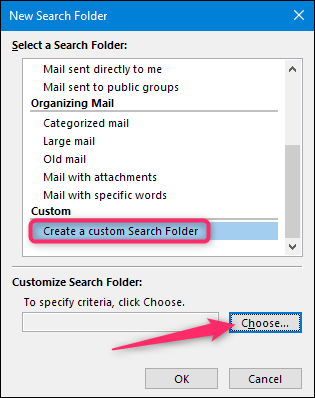
In the Custom Search Folder window, type in a name for your folder.
在“自定义搜索文件夹”窗口中,输入文件夹的名称。
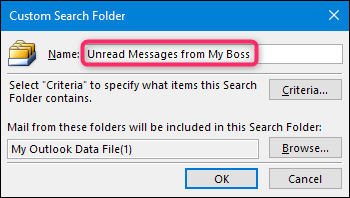
Next, you’ll set up the criteria for the search, so hit the “Criteria” button.
接下来,您将设置搜索条件,因此点击“条件”按钮。
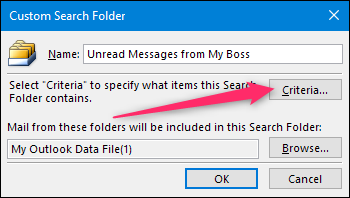
The Search Folder Criteria window lets you really customize your search, and you can select as many of the available criteria as you want.
“搜索文件夹条件”窗口可让您真正自定义搜索,并且可以根据需要选择尽可能多的可用条件。
The “Messages” tab contains basic criteria that lets you search for specific words in the subject or message body, senders, and recipients. You can also limit the search to messages where you are the only person on the “To” line or on the “To” or “Cc” line with other people.
“邮件”选项卡包含基本条件,可让您搜索主题或邮件正文,发件人和收件人中的特定单词。 您还可以将搜索限制为您是“收件人”行或“收件人”或“抄送”行中与其他人唯一的人的邮件。
And you can even specify a time range for the messages based on when they were received, sent, modified, and so on. So, for example, you could show only messages that were received in the last seven days.
您甚至可以根据邮件的接收,发送,修改时间等来指定邮件的时间范围。 因此,例如,您可以仅显示最近7天收到的邮件。
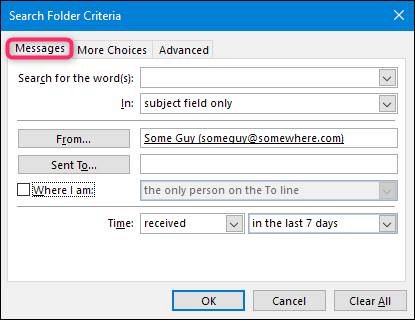
The “More Choices” tab provides even more criteria for narrowing down your search. You can search by messages in specific categories, those that are unread or have attachments, by the importance of the message, those that are flagged or not, and even by the actual size of the message. That last one can be helpful for finding and deleting large attachments, by the way.
“更多选择”标签为缩小搜索范围提供了更多条件。 您可以按特定类别的邮件,未读或带有附件的邮件,按邮件的重要性,是否已标记的邮件,甚至按邮件的实际大小进行搜索。 顺便说一句,最后一个有助于查找和删除大型附件。
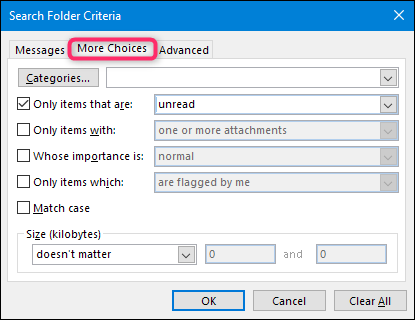
The “Advanced” tab lets you add criteria based on all the fields an Outlook object can store. There are loads of them, so we won’t cover them here. But if you need to search by something you haven’t found on the other tabs, the chances are you’ll find it by clicking that “Field” button and browsing the menus.
“高级”选项卡使您可以基于Outlook对象可以存储的所有字段添加条件。 它们很多,因此我们在这里不介绍它们。 但是,如果您需要搜索其他选项卡上未找到的内容,则可以通过单击“字段”按钮并浏览菜单来找到它。
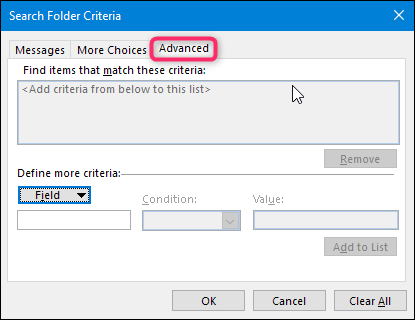
When you’re done setting all the criteria you want on those three tabs, go ahead and click the “OK” button to return to the Custom Search Folder window. There’s one more thing you might want to configure here before you’re done.
在这三个选项卡上设置完所有所需条件后,继续并单击“确定”按钮以返回到“自定义搜索文件夹”窗口。 完成之前,您可能还需要在此处配置另一件事。
By default, the custom search you create will pull from all the folders in your Outlook data file. If you want to limit that to just certain folders, click the “Browse” button.
默认情况下,您创建的自定义搜索将从Outlook数据文件中的所有文件夹中提取。 如果要将其限制为仅某些文件夹,请单击“浏览”按钮。

In the Select Folders window, select the folders you want to include in the search, and then click the “OK” button.
在“选择文件夹”窗口中,选择要包括在搜索中的文件夹,然后单击“确定”按钮。
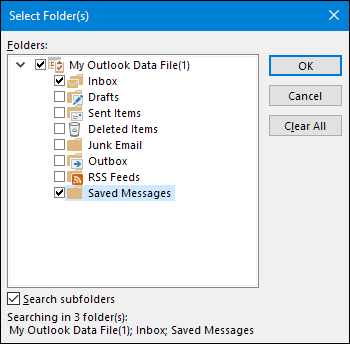
And then back in the main Customize window, go ahead and click “OK” again.
然后回到“自定义”主窗口,继续并再次单击“确定”。
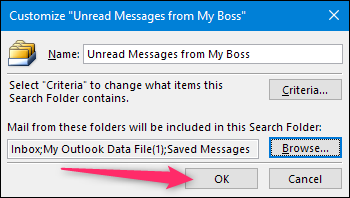
Outlook create the custom search folder and adds it to your folder view.
Outlook创建自定义搜索文件夹并将其添加到您的文件夹视图。
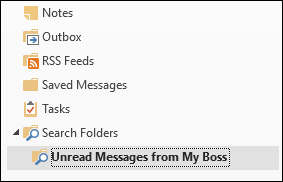
Once you get the hang of using it, the Custom Search Folder feature is pretty powerful. Here are just a few examples of things you could use search folders for:
一旦掌握了使用它的功能,“自定义搜索文件夹”功能将非常强大。 这只是您可以使用搜索文件夹进行操作的一些示例:
- Messages to and from your boss 老板发来的消息
- Messages with unresolved followup flags by category (for example, you could search for only the unresolved items in the personal category) 按类别具有未解决的后续标记的邮件(例如,您只能搜索个人类别中的未解决的项目)
- Messages with high importance 重要讯息
- Messages to and from a client (You could even use their full domain in the search box and choose to search all fields) 与客户之间的邮件(您甚至可以在搜索框中使用其完整域,然后选择搜索所有字段)
- Messages with attachments and that are over a certain size (great for getting rid of big attachments and reducing the size of your data file) 带有附件且大小超过一定的邮件(非常适合删除大型附件并减小数据文件的大小)
And that just scratches the surface. So, what kinds of search folders do you create? Let us know in the comments!
但这只是表面。 那么,您创建哪种搜索文件夹? 让我们在评论中知道!
翻译自: https://www.howtogeek.com/359538/save-time-with-custom-search-folders-in-microsoft-outlook/
outlook自定义快捷键





















 1191
1191











 被折叠的 条评论
为什么被折叠?
被折叠的 条评论
为什么被折叠?








